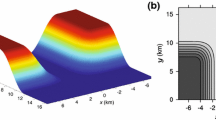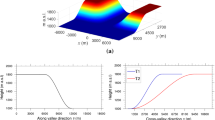Summary
With the typical geometry of a large Alpine valley in mind, a box-type model consisting of only one (Alpine) basin, the “forelands”, and one valley tube connecting those two has been set up. Using drastically simplified equations of motion, continuity and heat, and supposing weak-gradient synoptic conditions, a periodic solution for the daily wave of the valley wind regime is obtained.
Fundamental concepts like the area-height distribution of valley segments, or the role of slope winds and other fast-reacting local circulations in heating or cooling the main valley and larger basins, are being incorporated. The solution has valley wind speeds correct in amplitude and phase, maximum upvalley wind occurring around 16 h local time. Valley winds attempt to equalize horizontal pressure differences, which are caused by the fact that the interior of valleys is being heated and cooled more strongly by a factor of 2 or more than the atmosphere over the adjacent plain = “foreland”. In this attempt, they reduce the temperature contrast somewhat, but not very much, because friction in the valley is a dominating process. The present model also nicely reproduces observed features of the daily pressure wave, including the existence of a “level of pressure equalization” (between the valley interior and the plain) at about crest height.
Zusammenfassung
Ich habe das typische Relief eines großen Alpentals vor Augen, und konstruiere ein “Schachtel”-Modell, das drei schematische Regionen umfaßt: ein inneralpines Becken, das Alpenvorland, und eine Talröhre, die diese beiden verbindet. Die Impuls-, Kontinuitäts- und thermodynamische Gleichung werden in stark vereinfachter Form angesetzt, wobei eine gradientschwache Wetterlage vorausgesetzt wird. Wir untersuchen die tagesperiodische Lösung dieses Systems für Talwind, Temperatur, Luftdruck. In diesen Gleichungsansatz wurden grundlegende Konzepte eingearbeitet: z.B. die Flächen-Höhenverteilung des Beckens, oder die Rolle der Hangwinde und anderer kleinräumiger, schnell reagierender thermischer Zirkulationen, die die lokale Erwärmung/Abkühlung dem Haupttal bzw. größeren Talbecken mitteilen. Die vorliegende Lösung zeigt Talwindgeschwindigkeiten, deren Amplitude und Phase mit den Beobachtungen gut übereinstimmen: der Taleinwind hat sein Maximum um ca. 16 Uhr Lokalzeit (MEZ). Die Talwinde sind ein Versuch, horizontale Druckdifferenzen auszugleichen, die wiederum auf Grund der Tatsache entstehen, daß die Erwärmung/Abkühlung des Taiinneren um mehr als den Faktor 2 stärker ist als die der Luftsäule über dem angrenzenden Vorland. Bei diesem Versuch reduzieren die Talwinde den Temperaturkontrast, aber nur um weniges, da die Ausgleichsströmung durch die Talröhre starker Reibung unterliegt. Schließlich reproduziert das vorliegende Modell in zufriedenstellender Weise den tagesperiodischen Druckgang, wie er in verschiedenen Höhen beobachtet wird, vor allem auch das sogenannte “Druckausgleichsniveau”, das ungefähr in Kammhöhe liegt.
Similar content being viewed by others
References
Egger J (1981) Thermally forced circulations in a valley. Geophys Astrophys Fluid Dynamics 17: 255–279
Egger J (1986) Simple valley flow models, Part I. Met Atm Phys, special ALPEX issue
Nickus U, Vergeiner I (1984) The thermal structure of the Inn Valley Atmosphere. Arch Met Geoph Biokl A33: 199–215
Steinacker R (1984) Area-height distribution of a valley and its relation to the valley wind. Beitr Phys Atm 57(1)
Vergeiner I (1983) Dynamik alpiner Windsysteme. Bericht zum Forschungsvorhaben “3556” (Fonds). Institut für Meteorologie und Geophysik, Universität Innsbruck
Author information
Authors and Affiliations
Additional information
With 2 Figures
Rights and permissions
About this article
Cite this article
Vergeiner, I. An elementary valley wind model. Meteorl. Atmos. Phys. 36, 255–263 (1987). https://doi.org/10.1007/BF01045153
Received:
Issue Date:
DOI: https://doi.org/10.1007/BF01045153




